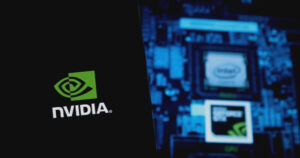Unlocking the Power of AI: NVIDIA’s Blackwell Architecture Takes Center Stage
By: Luisa Crawford
Publication Date: June 4, 2025
In a groundbreaking leap for artificial intelligence, NVIDIA’s new Blackwell architecture has emerged as a game-changer, showcasing incredible performance improvements in the latest MLPerf Training v5.0 benchmarks. With reported training times up to 2.6x faster than previous models, the Blackwell architecture is setting a new standard for efficiency in machine learning.

Architectural Innovations Driving Performance
What sets Blackwell apart from its predecessor, Hopper? The introduction of fifth-generation NVLink and NVLink Switch technologies enhances GPU communication, significantly increasing bandwidth. This is critical for reducing training times and maximizing throughput, especially vital in processing large language models (LLMs) and complex AI tasks.
The improvements don’t stop there. Blackwell also features a second-generation Transformer Engine and HBM3e memory, resulting in faster and more efficient model training. NVIDIA’s advanced GB200 NVL72 system exemplifies this capability, achieving astonishing benchmarks such as training the Llama 3.1 (405B model) a remarkable 2.2x quicker than using the Hopper architecture. This system can achieve up to 1,960 TFLOPS in training throughput, cementing its place at the forefront of AI technology.
Performance Excellence Across Key Benchmarks
MLPerf Training v5.0 is renowned for its challenging benchmarks across various domains, including LLM pretraining, text-to-image generation, and graph neural networks. NVIDIA’s Blackwell architecture has excelled across all seven benchmarks, combining speed and efficiency with remarkable results.
For instance, when fine-tuning the Llama 2 (70B model), Blackwell GPUs delivered a 2.5x speedup compared to previous submissions using the DGX H100 system. The performance record extends to the Stable Diffusion v2 pretraining benchmark, where Blackwell achieved a 2.6x increase per GPU, setting a new standard in AI training performance.
Implications for the Future of AI
These substantial performance improvements signify more than just technical advancements; they represent a shift in how organizations can leverage AI models. Speedier training and fine-tuning accelerate the deployment of innovative AI applications, granting organizations a competitive advantage in an increasingly digital marketplace.
NVIDIA is also committed to optimizing its software stack, including critical libraries like cuBLAS and cuDNN. This dedication to software-hardware synergy optimizes the use of Blackwell’s computational prowess, catering specifically to the needs of modern AI data formats.
Why Blackwell Matters
As organizations increasingly rely on complex, large-scale AI models, NVIDIA’s innovations position the company to maintain its leadership in AI hardware. Blackwell’s advancements address the growing demands for speed and efficiency in model training, making it a vital tool for developers, researchers, and businesses alike.
For unparalleled insights and the latest developments in AI and cryptocurrency technologies, stay tuned to Extreme Investor Network. We are dedicated to providing in-depth analysis and expertise that empowers our readers in navigating the fast-evolving landscape of investments and technology.
For further details about NVIDIA’s performance in MLPerf Training v5.0, check out the official NVIDIA blog.
Image Source: Shutterstock

